Collecting dollar bills can be a fun and rewarding hobby. There are many different ways to collect dollar bills, so you can tailor your collection to your own interests. You can focus on a certain type of bill, such as $20 bills from a certain year, or you can try to assemble a complete set of all the different types of bills. Today, we’re talking about $2 bills.
Do you have any old two dollar bills lying around? If so, you may be wondering how much they are worth. In this blog post, we will talk about the value of 1976 two dollar bills. We will also provide some tips on how to sell them if you want to get the most money for them. So, if you’re curious about how much your old $2 bill is worth, keep reading!
What Is Special About a 1976 $2 Bill?
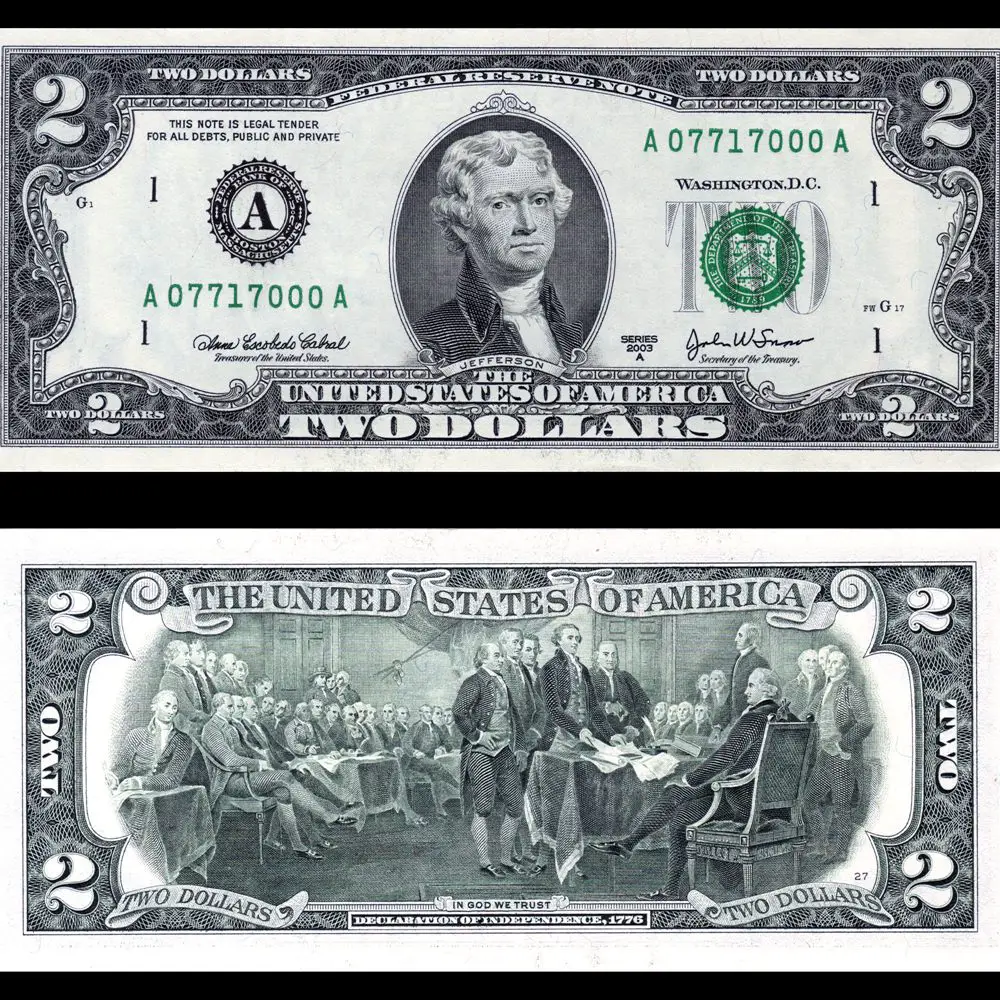
In 1976, the United States government began issuing a new two dollar bill to replace the older United States Note design. The new design was released in conjunction with the country’s bicentennial. It marked the 200th anniversary of the signing of the Declaration of Independence.
The 1976 two dollar bill was part of a series that featured redesigned currency. The most notable change was on the back of the bill where an image of the Declaration of Independence replaced the previous image of Jefferson’s Monticello estate. The front of the bill still featured a portrait of Jefferson.
It was also the first time the color scheme changed. The bill now had a green seal instead of a red seal. This was done to help deter counterfeiters.
How Rare Is the 1976 Two-Dollar Bill?
Generally speaking, two-dollar bills are the rarest currently-circulating denomination of United States currency. Since the 1950s, there have been very low printing numbers for the $2 bill, resulting in few bills remaining in circulation. Consequently, collectors are willing to pay a high price for authentic $2 bills, making them a valuable commodity.
Factors That Determine the 1976 2 Dollar Bill Value
There are a few key factors that will affect the value of a 1976 $2 bill. These include the bill’s condition, rarity, serial number, whether it’s a star note, and if there are any misprints. Let’s take a closer look at these factors.
Condition
The most important factor in determining the value of a 1976 two dollar bill is its condition. If the bill is in pristine condition, with no folds or creases, it will be worth more than a bill that is heavily worn. Likewise, a bill that has been damaged by water or fire will be worth less than one that is in good condition.
Uncirculated two dollar bills are worth more than circulated ones, since they have never been used and thus are in pristine condition. However, even a circulated bill can be valuable if it is in good condition.
PMG is a professional Numismatic company that provides an accurate description and assessment of a note’s condition, backed by a guarantee of authenticity. six main criteria of condition are: centering, margins, color, ink quality, brightness, and flaws. Each criterion is given a separate grade on a scale from 1 to 70, with 70 representing a perfect note. Overall condition is determined by averaging the grades of the six main criteria.
Rarity
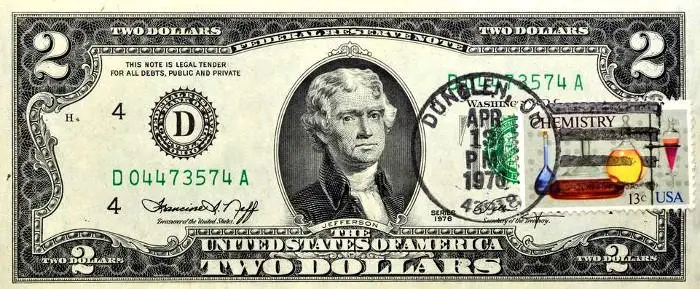
The value of any currency, be it paper or metal, is largely dependent on how rare it is. The same holds true for the 1976 two dollar bill. Bills that were issued on the first day of production tend to be more valuable than those that were not. Those bills usually have an interesting post office stamp on them or a bunch of signatures.
Serial Numbers
When it comes to collecting currency, many people focus on two dollar bills with interesting serial numbers. Repeated numbers, such as 111222333, are highly coveted, as are binary numbers (101010) and radar numbers (313131).
A “double quad” is a bill with two sets of four identical digits in the serial number (e.g., 12121212). A “seven in a row” is a bill with seven consecutive digits that are all the same (e.g., 9999999).
While the odds of finding a bill with one of these patterns is quite low, they can be worth hundreds or even thousands of dollars. So next time you’re thumbing through your wallet, keep an eye out for those special serial numbers – you might just have a hidden treasure on your hands.
You can use this 1976 $2 dollar bill serial number lookup to see how much your bill could be worth.
Star Notes
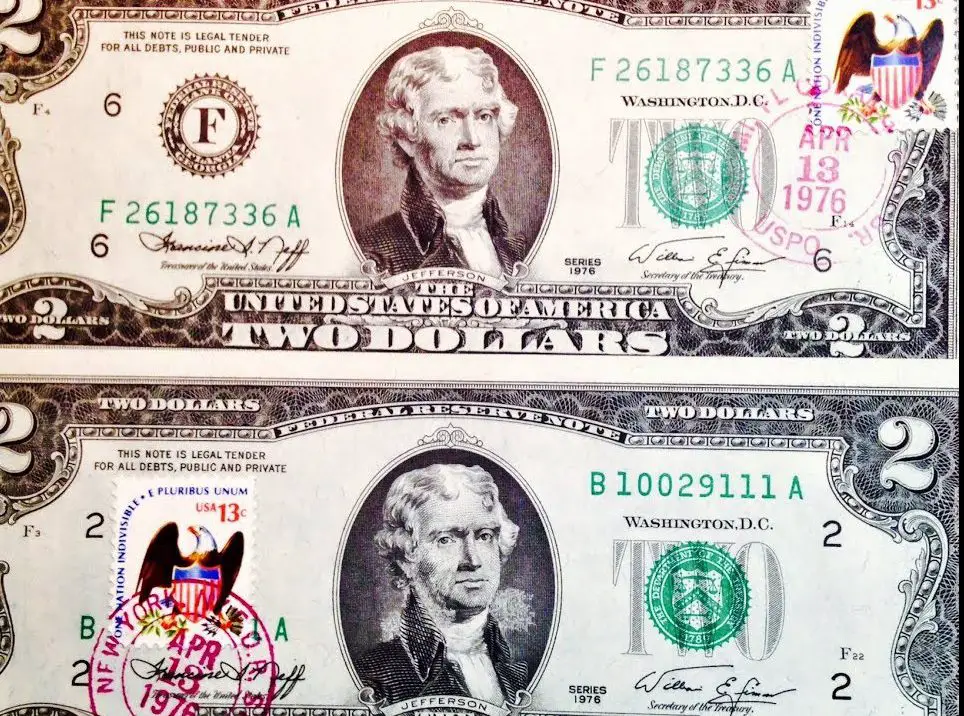
In the world of currency, a “star note” is a bill that has a star instead of a letter in the serial number. Star notes are used by the United States Treasury Department when there is a problem with the printing plate during the production process. As a result, star notes are much scarcer than regular notes and are highly prized by collectors.
Although the price of a 1976 star note 2 dollar bill depends on its condition, they are generally worth much more than regular bills. And if they have an interesting serial number – the value increases!
Misprints
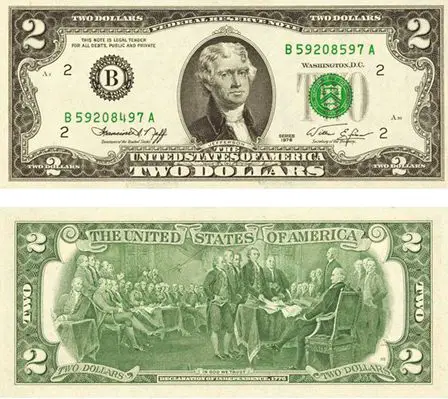
One factor that can affect the value of a bill is whether or not it contains a misprint. While errors on paper currency are relatively rare, they can occur during the printing process. If a bill contains a printing error, it will often be much more valuable than a bill that doesn’t contain any errors.
The 1976 two dollar error bill features one of the more interesting printing errors of U.S. paper currency. Normally, the serial number on a bill is printed in two places: the top right and the bottom left. However, on some 1976 2 dollar bills, the serial numbers are different. This error was likely caused by a misalignment of the printing plates, resulting in two different serial numbers being printed.
What is the 1976 2 Dollar Bill Value?
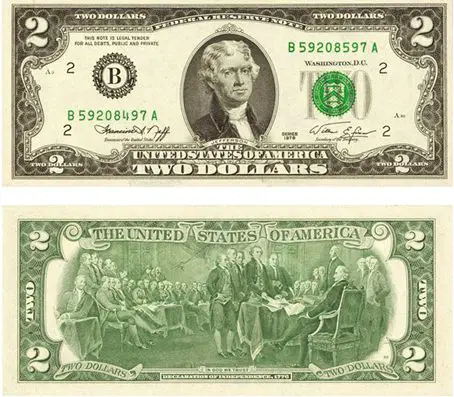
The $2 bill is actually one of the least commonly circulated denominations of U.S. currency, which might make you think that it would be worth more than its face value. However, most $2 bills are not particularly valuable, and most circulated notes are only worth their face value of $2.
Uncirculated notes in pristine condition can be worth around $9-15, but even those are relatively common. The real rarity are 2 dollar bills with interesting serial numbers which can be worth a few dollars more.
What is the Value of a 1976 2 Dollar Star Note?
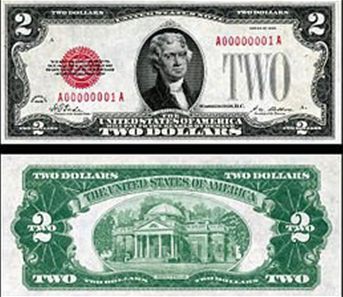
Because they’re produced in limited quantities, star notes are typically much rarer than regular bills, making them highly sought-after by collectors. Most 1976 $2 star notes are typically worth around $8 in fine condition, but in uncirculated condition, with an MS 63 grade, they can be worth $20-25.
Star notes printed in Kansas City and the Federal Reserve Bank of Minneapolis can sell for around $80 in fine condition and around $150 in uncirculated condition with a grade of MS 63. That’s because they’re rarer than other bills, and therefore more coveted by collectors.
Look on the front left-hand side of your bill for the name of the issuing bank. Star notes are only worth a premium if they’re in near-perfect condition, so unless you have a bill that looks like it just came off the printing press, it’s probably not worth more than face value.
1976 $2 Dollar Bill Value Chart
Here is a rare 1976 $2 dollar bill value chart that can help you determine how much your bill could be worth:
Type |
Condition |
Price |
Regular 1976 $2 bill |
Circulated |
$2 |
Regular 1976 $2 bill |
Uncirculated |
$9-15 |
Regular 1976 $2 star note |
Circulated |
$8 |
Regular 1976 $2 star note |
Uncirculated |
$20-25 |
Rare print 1976 $2 star note |
Circulated |
$80 |
Rare print 1976 $2 star note |
Uncirculated |
$150 |
1976 $2 bill with mismatched serial numbers |
Circulated/uncirculated |
$500-700 |
How Do I Know If My 1976 Two Dollar Bill Is Worth Anything?
While some two dollar bills are worth more than face value, most are not. But how can you tell if your bill is actually valuable?
Compare Prices to Recently Sold Items
One way to gauge the value of your 1976 two dollar bill is to compare it to similar items that have sold recently. Take a look at online auction sites and see what similar bills in similar conditions have gone for. This will give you a good idea of the general range that your bill might fall into.
- A 1976 $2 federal reserve note in the uncirculated condition sold for $15.
- An uncirculated 2 dollar bill stamped and postmarked in Milwaukee sold for $19 on eBay recently.
- A lot of 86 uncirculated two dollar bils sold for $370, so you might have a better chance of getting a premium price if you’re selling in bulk.
- Similarly, alot of 15 uncirculated two dollar bills sold for around $15.
- Three two dollar bills in consecutive order sold for $8,50.
- A1976 $2 star note sold for almost $50!
Of course, the final value of your 1976 two dollar bill will also depend on its condition. If the bill is in pristine condition, it will be worth more than one that is heavily worn or has been damaged in some way.
Helpful Resources
Here are some helpful resources that we recommend:
- Collector’s Guide to Modern Federal Reserve Notes Series 1963-2009 by Robert Azpiazu
- Warman’s U.S. Coins & Currency Field Guide (Warmans U S Coins and Currency Field Guide) by Arlyn Sieber
- A Guide Book of United States Paper Money 7th Edition by Arthur L Friedberg
- Standard Catalog of United States Paper Money by Maggie Judkins and William
Getting Your Bill Graded and Appraised
The best way to find out how much your 1976 two dollar bill is worth is to take it to a professional currency dealer and have it graded. The dealer will be able to tell you if your bill is in good enough condition to be worth more than its face value. You can also have your bill appraised by a professional numismatist. This will give you a more accurate idea of its value, but it will also cost more money.
In general, unless your bill is in pristine condition, it is not likely to be worth more than a few dollars. Nevertheless, it is always fun to find out how much your old currency is worth!
Where to Sell Your 1976 2 Dollar Bill for the Biggest Price
If you’ve got a 1976 2 dollar bill, you may be wondering where you can sell it for the biggest price. Many coin shops are always on the lookout for rare bills, and they’re often willing to pay top dollar for them. If you have a local coin shop, it’s worth stopping by to see if they’re interested in your bill. You can find a coin shop near you with the help of Amex.
Your best bet is probably eBay. There are always plenty of collectors looking for rare bills, and you’re likely to get a good price if you list your bill on the site. You can also try Heritage Auctions, which specializes in collectible items. Whichever route you choose, make sure to do your research so you get the best possible price for your bill.
If you’re looking to sell your 1976 2 dollar bill, there are a few things you can do to ensure you get the best price possible. Take clear, well-lit photos of the front and back of the bill, as potential buyers will want to see what they’re getting. Provide as much information as possible about the bill in your listing. Potential buyers will want to know its history and any special circumstances surrounding its printing.
Be patient and be willing to negotiate – if you’re flexible on price, you’re more likely to find a buyer who’s willing to pay what you’re asking.
Conclusion
Most 1976 $2 bills are only worth their face value of $2. However, star notes or bills with interesting serial numbers can be worth more to collectors. Star notes are bill prints that replace ones that had mistakes during production. They are distinguishable by a star symbol in the serial number. Because they are rare, star notes from 1976 can sell for $8 or more. Similarly, bills with unique serial numbers, such as 01234567 or 11111111, can also be worth more to collectors.
So, if you come across a 1976 $2 bill, don’t expect to retire on your windfall. But if you have a 1976 $2 bill that meets one or more of these criteria, it might be worth more than its face value. Thanks for reading!
